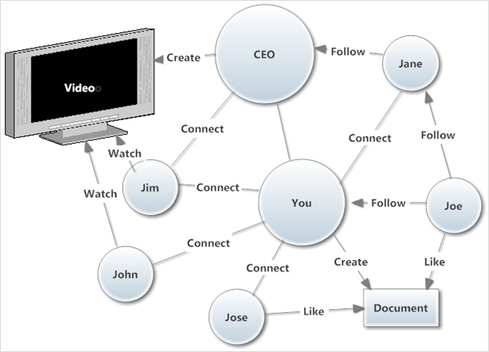To make social collaboration work, focus on creating and reinforcing the underlying connections.

Another significance of the social network is it helps us get to know people we might not have a relationship with otherwise. David Levin is the CEO of UBM, the company behind InformationWeek and many other trade magazines and tradeshows. Because he’s off in London and many levels of hierarchy removed from me, really the only way I know him is through our internal social network. He’s not afraid to show personality by posting personal notes from time to time. The screen shot of his profile that he allowed me to share in my book included Richie Havens, from the day the folk singer died. That's not necessarily typical of the messages he puts out, but if he'd been posting about something more sensitive and proprietary I wouldn't have been allowed to share it.
Levin and our other senior executives do most of their corporate communications through the social network because it’s a better way of getting feedback from across the company. Also, because UBM grew through acquisitions, the social network is a tool for knitting the whole organization together and helping us act more like one company.
Kristin Waryas, who we recognized at the 2013 E2 conference as our social business leader of the year, runs the social collaboration project at State Street, a global financial services firm. Her social profile is tagged with areas of expertise, which is another way of creating relationships. Anytime someone posts a question that is tagged with one of those topic areas, she sees it and can respond.

Ask Me About profile tagging in NewsGator.
As a firm in a conservative, regulated industry, State Street decided to use NewsGator, a product based on Microsoft SharePoint that it could run on servers inside its firewall. But whether on premises or in the cloud, the point of a collaboration network is to open up new lines of communication and new possibilities for collaboration.
One of the first things State Street did with this platform was hold an “idea rally” that produced 12,000 posts about products, which it turned into 400 projects aimed at capitalizing on the best ideas. The volume of responses was so overwhelming that it now uses some additional tools specifically designed for identifying the best ideas from one of these online brainstorming sessions.
Bottom line: Social collaboration can work, and it can work well. But take it from a Dummy: the way to make it work is to focus on the connections, not the software.
Follow David F. Carr on Twitter @davidfcarr or Google+. He is the author of Social Collaboration For Dummies (October 2013).
About the Author(s)
You May Also Like







